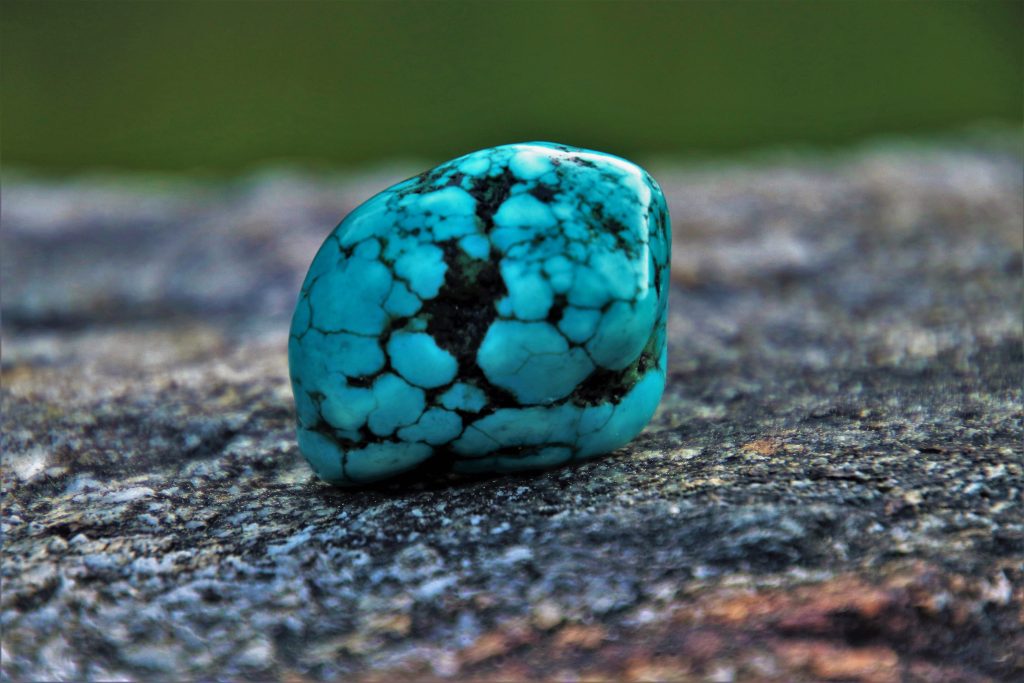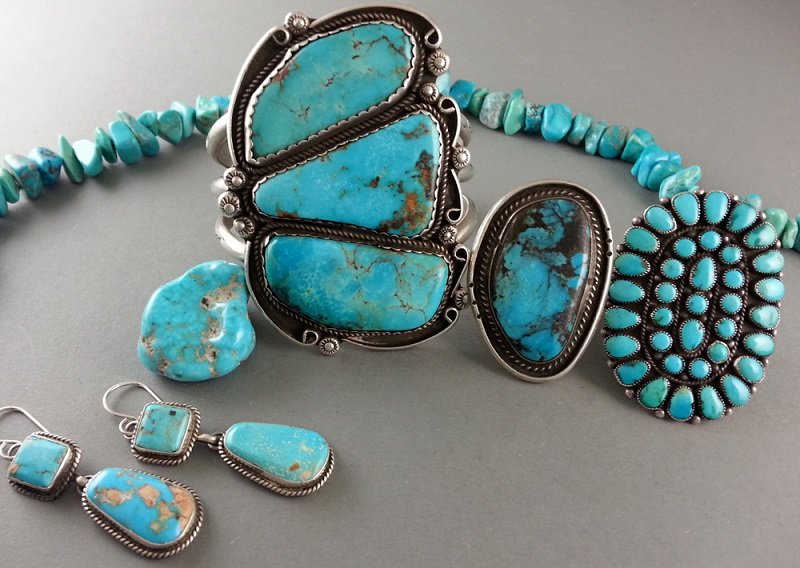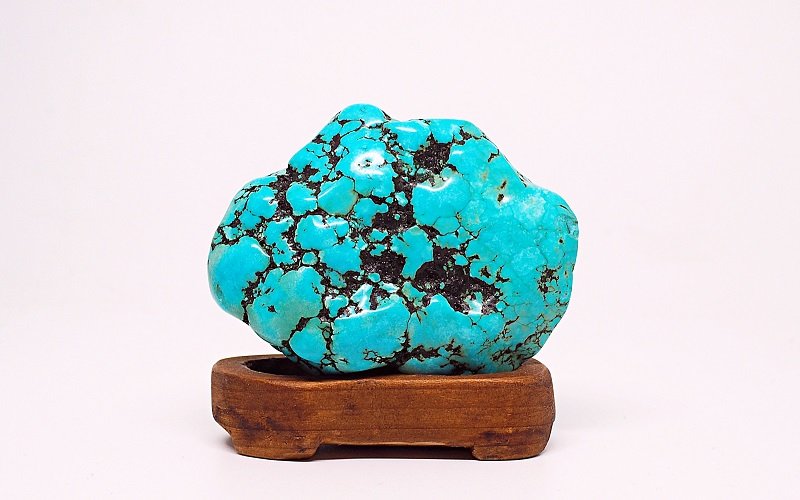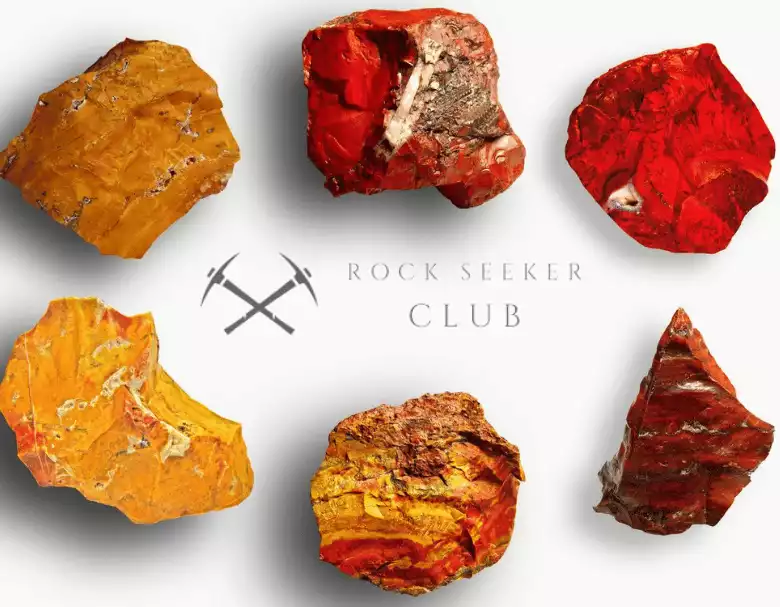Turquoise is a blue-to-green cryptocrystalline mineral with a Mohs hardness of 3 to 6, and is always opaque. It can contain matrix from other minerals or be eye-clean. The most common color of turquoise is close to robin’s egg blue, but the colors can range from blue with the slightest hint of green and green with the slightest hint of blue. Its primary mineral content is copper and aluminum, but there are turquoise specimens that have gold forming the veins.
Turquoise is a beautiful stone that has caught the eye of people for millennia and has carried value since its discovery. It comes in a variety of grades that range from low to high with the lower grades being worth the least due to the need for stabilization to keep it intact.

High-grade turquoise is higher on the Mohs scale, has an even color throughout the specimen, and polishes into a smooth, glossy stone that is perfect for turning into jewelry. It also looks beautiful in its rough form, adding an intense robin’s egg blue color to the mineral collector’s cabinet.
This luscious mineral is found in regions around the world, but the most well-known sources are found in the American Southwest. Its value is derived from its origin, color, visual appearance, association with a region, hardness, and size. Turquoise is weighed in carats, and five carats is equivalent to one gram. That means the heavier the stone, the more it’s worth.
How to Determine the Value of Turquoise

Determining the value of turquoise comes down to a few factors, but the most important ones are color, appearance, size, and source. Certain colors of turquoise are often associated with a specific source and can add to the value of the stone.
The appearance of turquoise is commonly associated with veins or matrix derived from the metal or stone that it formed within. Last, but not least, the weight of a piece of finished or unfinished turquoise plays a role in its valuation due to the fact it’s weighed in carats the same as other precious gems.
Appearance
The visual appearance of turquoise is commonly associated with copper veins or mottling running through a specimen or a cabochon. Turquoise is formed when water that contains turquoise-forming minerals flows through openings in a rock.
This gives turquoise its signature appearance of veining. It also results in a specimen that’s lumpy or pebbly. The most common type of rocks that cause the veins are volcanic, sedimentary, or aluminum-rich minerals.

Color
Color is a major factor in the value of turquoise, but it’s not always related to depth. Local minerals affect the color of the turquoise and sometimes a lighter color of turquoise is considered valuable due to its intrinsic qualities as opposed to color alone. However, specimens that have rich, deep colors are highly prized by collectors and tend to be more valuable than the “average” color of turquoise.
Weight
Turquoise ranges from light to heavy in terms of density. The lighter the piece, the more likely it is to be of low quality. The lower end of turquoise is chalky and crumbly, and won’t hold up to being shaped for a cabochon. Better quality turquoise has a density that allows it to be easily worked into a finished product or displayed as a mineral specimen. The more a specimen weighs, the higher the quality, and the higher its value.
Source
Turquoise is found around the world, but the largest and most famous deposits are found in the American Southwest. Two mines that are still producing high-quality turquoise are Sleeping Beauty and Kingman. These mines are still producing high-grade turquoise specimens prized by collectors. Some mines produced small quantities of high-grade turquoise for a short period of time, then played out. Specmiens from these mines are highly valued due to their scarcity and quality.

Factors That Affect the Value of Turquoise
Turquoise has several factors that affect its value. They include:
- Color
- Metal or matrix content
- Matrix or webbing
Other factors that affect the value of a piece of turquoise include its composition, whether it’s been stabilized, or if the color has been enhanced. Lower-grade turquoise is usually soft and chalky, requiring stabilization to make it usable in jewelry or for display. This lowers the value of turquoise, and its value will increase slowly, if at all, over time.
Turquoise is easily dyed to give it an even, saturated color. This is frequently done to enhance the value of an average or lower-quality piece. A piece of dyed turquoise has little value and you should stay away from buying a piece that looks like it’s been dyed. However, it’s not always easy to tell when a piece of turquoise has been dyed. If you’re not sure, pass on the sale and keep looking.
Turquoise veins come from a few sources, and many consider veining to be an intrinsic part of the mineral. However, some mines produce clean, non-veined rough that is highly prized by collectors. Persian turquoise is one example of a largely veinless variety that is very desirable and has high value. Some mines produce turquoise with gold veins, causing the stone to have a double value for its turquoise and gold content.
The Most Valuable Types and Colors of Turquoise
Persian blue is the most valuable type and color of turquoise. It originates from the Nishapur region of Iran and is an intense medium blue-green in color. Specimens are mostly free of veining and can look like shell pearl upon first glance.
The Carico Lake Turquoise mine produces specimens in a wide range of colors, but 3% of its output consists of material with an apple green color. This is the only mine known to contain naturally ocurring turquoise of the vivid green color.
The Bisbuee Turquoise mine started out as a copper mine, then was converted to a turquoise mine. A total of 2,000 pounds of high-quality turquoise was recovered from the mine, and the mine was closed in 1980, making Bisbee turquoise some of the rarest and most coveted.
FAQs About Turquoise
Where are the largest deposits of turquoise found?
The largest deposits of turquoise are found in Arizona and Nevada with the bulk of turquoise coming from Arizona.
Can turquoise have gold in it?
Yes, turquoise can have veins of gold running through it. Deposits of turquoise with gold veins are found from time to time.
What happens to turquoise if it gets wet?
Turquoise can change color if it gets wet and become permanently altered. The pourous nature of the material allows water to pass through
Where can you hunt for turquoise?
There are a handful of turquoise mines open to the public in Nevada and Arizona. You can go to a fee-based mine that allows you to go through the tailings or dig for yourself.
- Online rock and mineral club for collectors of all levels!
- Find community with like-minded rock and mineral enthusiasts.
- Monthly Giveaways!
- Free Access to Entire Digital Library of Products (annual memberships)


